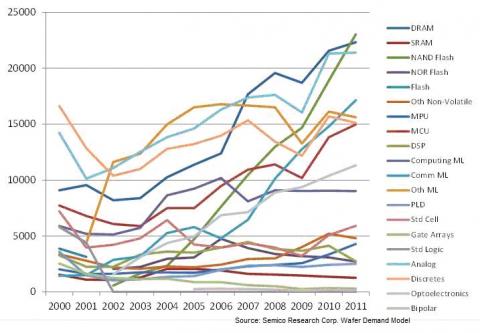You are here
We Break Down Wafer Demand So You Don't Have To

Phoenix, Arizona April 25, 2012 - Wafer demand grows at a compound annual growth rate of about 8-9%, but you could be making a big mistake if you think capital investment in fab capacity will be successful by sticking with an 8-10% investment rate every year.
Wafer demand growth is anything but stable, regardless of its CAGR. There is almost a 50-point spread between the peak growth year to the worst year of decline. Even if we throw out the worst year (-23% decline in 2001) and the best year (25% growth in 1995) the change in wafer demand growth rates range from -2.7% up to 24.9%.
The challenge in forecasting this market is the fact that there are thousands of semiconductor products that do not move in concert. In 2012, wafer demand for NAND flash products will increase by over 30%, while DSP wafers will experience a decline. The industry's wafer manufacturing facilities utilize over four different wafer sizes and numerous process technologies. When leading companies attempt to grab market share, often times the result is the creation of inventory gluts and shortages. Add supply chain bottlenecks into the mix, technology and product migration, and capacity planning becomes a nightmare.
Intel is ramping its 22nm product lines, and the foundries are filling their 32nm/28nm capacity. At the same time we continue to see growing demand for mature capacity for MEMS, image sensors, power management, discretes and opto chips. Put all this together, and a CAGR of 8% means very little when it comes to your capital investment planning.
Semico's wafer data goes back to 1991. Contact Jim Feldhan at 602-997-0337 to learn more about our Wafer Demand Data and see how we can help you navigate this colorful market.

Add new comment